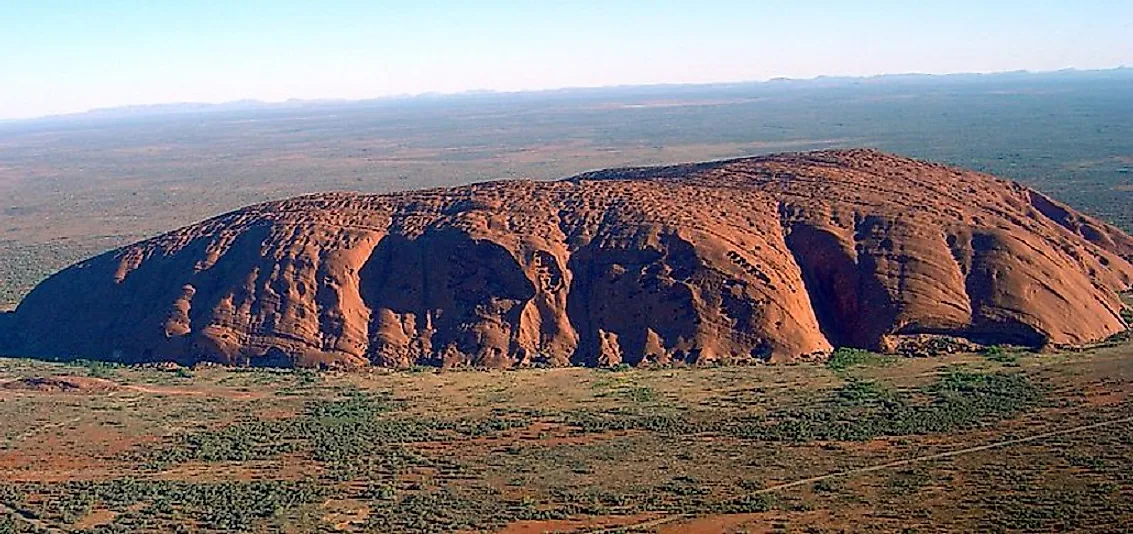What Do You Know About Ayers Rock (Uluru)?

5. Description
Ayers Rock, or Uluru, found located in the southwestern portions of the Northern Territory in central Australia, has a length of 3.6 kilometers and a width of 2.4 kilometers. Thereby, it is the world’s second largest monolith, after only Mount Augustus in Western Australia. The nearest town of Alice Springs is located at a distance of 450 kilometers by road from this rock formation. This sandstone rock monolith is geographically defined as a tor or an inselberg, which is to say an isolated landmass of weathered rock. The oval-shaped monolith rises to an elevation of 2,831 feet from its surrounding desert plain landscape, and forms one of the primary features of the Uluṟu-Kata Tjuṯa National Park. By virtue of its ecological and geological significance, the Uluru had also been designated as a UNESCO World Heritage Site in 1987.
4. Historical Role
The Uluru region was originally inhabited by the traditional aboriginal group of the Anagus. Europeans first started arriving into the area in the late 19th Century, and William Ernest Powell Giles and William Christie Gosse were the first European explorers to arrive in the region. Conflicts between the Anagus and the invading Europeans soon arose when the latter started claiming land in the region upon which to practice animal agriculture. Competition for food and land often resulted in violent clashes between the natives and new settlers, necessitating police patrols of the region. In 1920, however, a large part of the area in and around the Uluru was declared as an Aboriginal Reserve. Tourism first flourished in the region more than a decade later, with the first tourists arriving in the area in around 1936. Since the late 1950s onward, tourist facilities started rapidly developing in the Uluru region.
3. Modern Significance
Currently, the Uluru/Ayers Rock is a hot spot tourist destination in Australia, as the UNESCO World Heritage status of the site acts as a major crowd puller. Tourism in the region thus provides major regional and economic benefits to Australia as a whole. Several hotels, hostels, and camps operate in and around the Uluṟu-Kata Tjuṯa National Park, ensuring a comfortable stay for its tourists. Hiking and rock climbing are some of the most popular tourist activities offered at the park. Besides enjoying a high status among the global tourist world, the Uluru also reserves a special place in the hearts of its native inhabitants. The locals consider the rock formation to be sacred, and regard it as a wonder of creation. The Uluru landscape is also extremely significant for its ecological richness as it houses a plethora of rare and unique animal and plant species.
2. Habitat and Biodiversity
The area encompassing the Uluru monolith generally experiences a hot and dry climate, with high diurnal variations of temperature. Daytime temperatures in summer can be as high as 40° Celsius, while in winters temperatures at night drop well below freezing. Rainfall is maximum during the months of January to March, and periods of drought are not uncommon. Despite the harsh climatic conditions, a great variety of flora and fauna manage survive in and around the Uluru landscapes. 400 species of plants, including Desert oaks and poplars, eucalyptus, wildflower species, and blood-woods alike populate the Uluṟu-Kata Tjuṯa National Park. Mammals like Red kangaroos, marsupial moles, and seven species of bats are found in this eco-region. 73 species of reptiles are found in the Uluṟu-Kata Tjuṯa National Park, including such lizards as geckos and skinks and the endemic moloch, and snakes like the highly poisonous Death adder. Falcons, honey-eaters, budgerigars, and many other species of birds comprise the avian fauna of the ecoregion.
1. Environmental Threats and Territorial Disputes
The fact that thousands of tourists climb the Uluru rock every year is frowned upon by the indigenous owners of the land. Time and again, they have threatened to ban the tourist visitations to Uluru, which they claim houses several of their traditionally sacred sites. The introduction of new species into the Uluṟu-Kata Tjuṯa National Park habitats, like dogs, cats, rabbits, and foxes, has also greatly impacted the populations of native species in the region, driving 40% of the native species to extinction. The pressures induced by the tourism sector also tend to disturb the peace and sanctity of these natural habitats. Forest fires are common in the region, and have in the past destroyed the flora and fauna throughout large sections of the national park.











